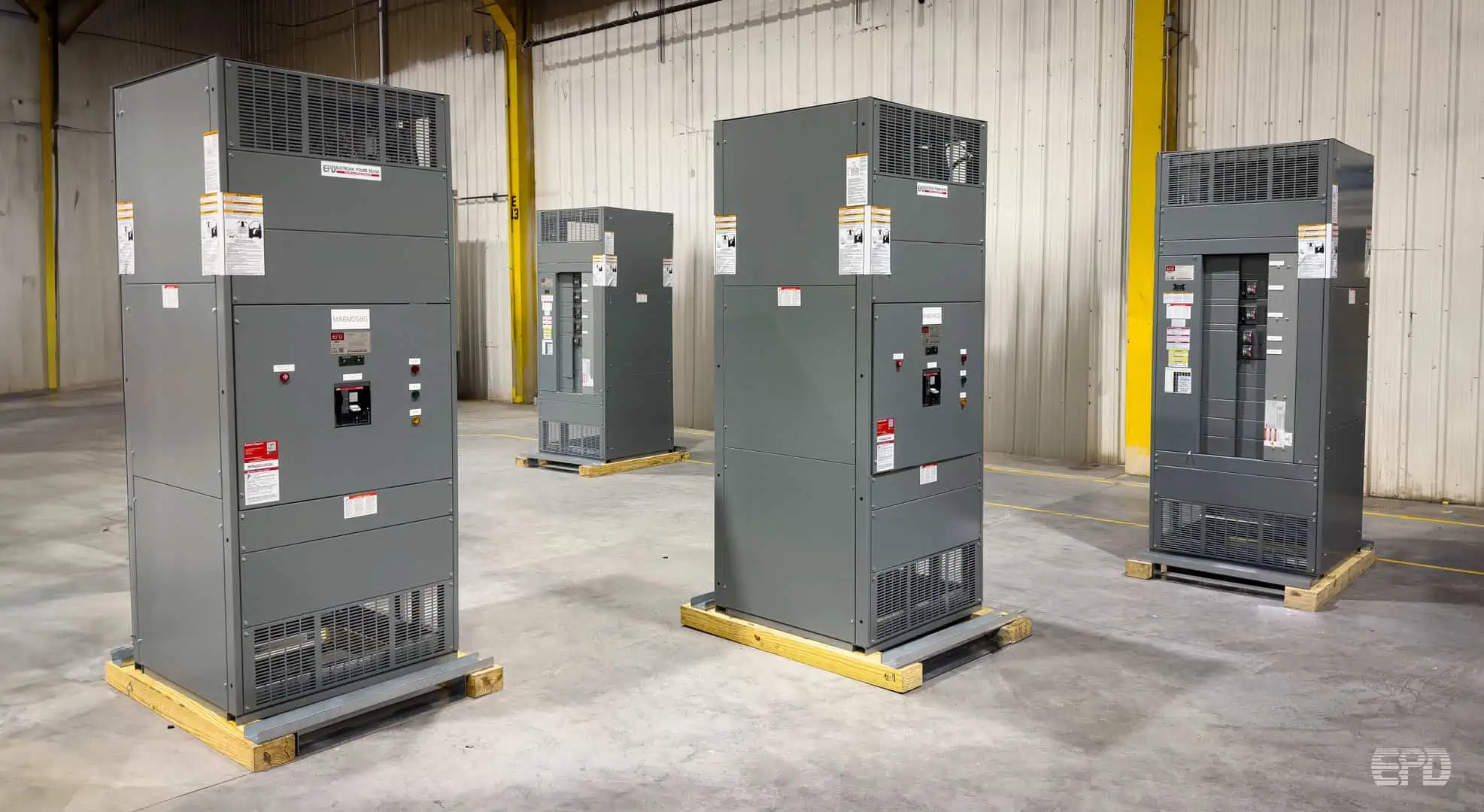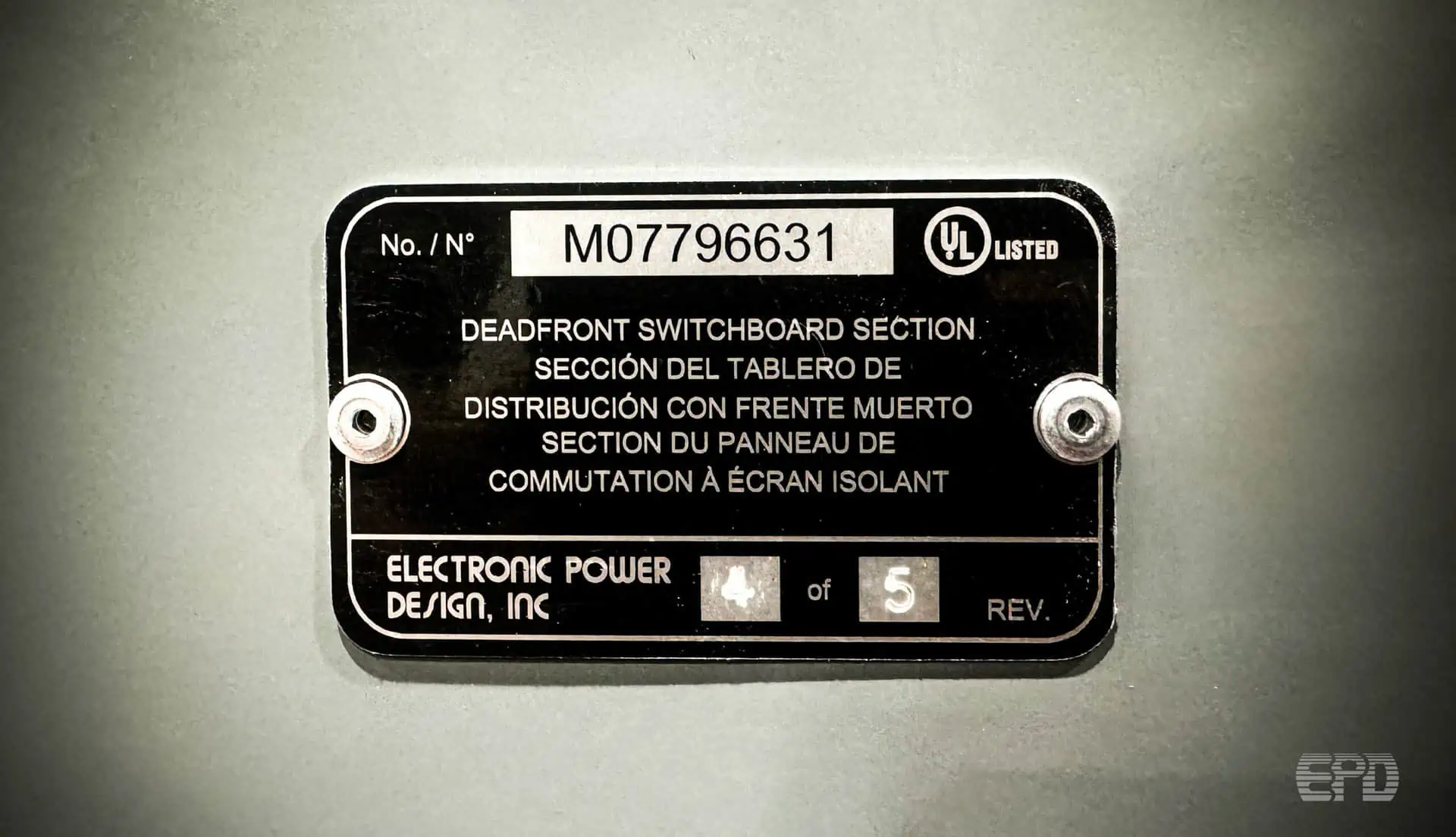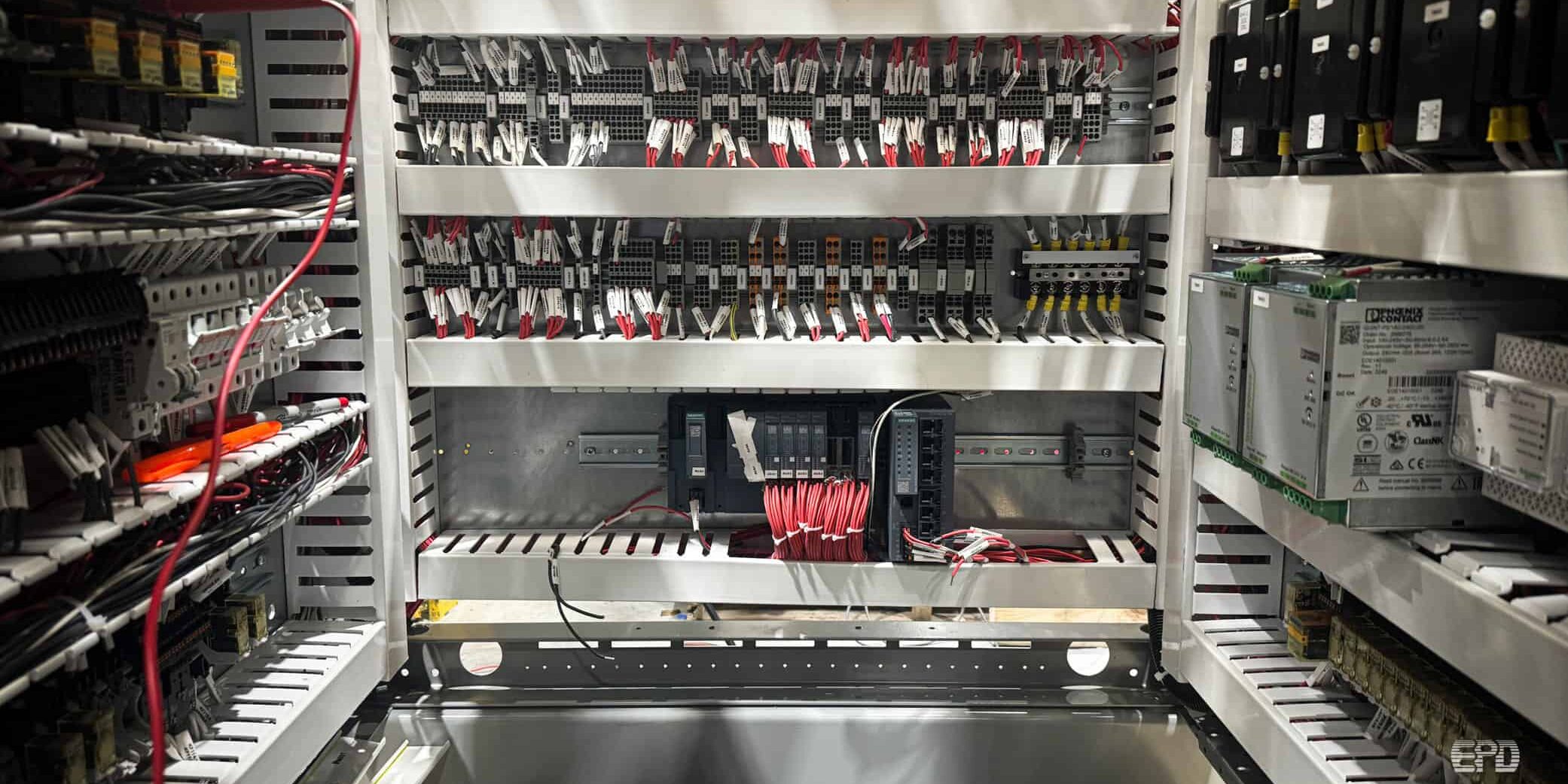Review of the Top Switchboard Manufacturers
Inside Look: The Top Switchboard Manufacturers Worldwide
As a leading electrical manufacturer, Electronic Power Design provides electrical engineers and contractors with a thorough exploration of switchboard manufacturing in this helpful resource.
Our primary objective is to help readers, regardless of their technical expertise, grasp the essentials of switchboards and make informed decisions when choosing the right manufacturer to meet their organization's specific needs.
March 1, 2024
Table of Contents:
Understanding Switchboard Manufacturing
- Top Global Switchboard Manufacturers
- Electronic Power Design (EPD)
- Schneider Electric
- ABB Ltd.
- Eaton Corporation
- Siemens AG
- Factors to Consider When Choosing a Switchboard Manufacturer
- Product Quality
- Pricing and Cost-effectiveness
- Dedicated Customer Service
- Fulfillment Speed
- Innovation and Technological Adaptation
- Technological Innovations in Switchboard Manufacturing
- Digitalization Taking Center Stage
- Automation Enhancing Efficiency
- Sustainability Through Innovation
- The Internet of Things (IoT) Changing the Game
- Regulatory Standards for Switchboard Manufacturers
- The Role of UL Standards
- NFPA 70: The National Electrical Code
- Ongoing Compliance Is Key
- Impact of Sustainability on Switchboard Manufacturing
- The Future of Sustainable Switchboards?
- Energy Efficiency: A Key Player
- Future Trends in Switchboard Manufacturing
- Increased Automation
- Digitalization
- Sustainability
- Growth in Custom Solutions
- Emergence of Smart Switchboards
- Challenges Faced by Switchboard Manufacturers
- Tough Market Competition
- Evolving Technological Landscape
- Navigating Regulatory Compliance
- Sustainability Pressures
- Switchboard Manufacturing FAQs
- What Does a Switchboard Builder Do?
- How Much Does a Switchboard Panel Cost?
- What Is the Difference between a Switchboard and a Panel Board?
- What Are Main Switchboards?
- Conclusion
Understanding Switchboard Manufacturing
Switchboards manage the distribution of power in electrical systems.
Manufacturing switchboards involves coordinating precise design engineering with the application of several innovative technologies.
But why do we need them? Basically, switchboards are like traffic cops for electricity. They direct the flow of power in an electrical system.
Switchboard manufacturing consists of four stages:
- Design and Planning: Manufacturing begins with design and planning. Manufacturers define specifications such as voltage level, current rating, and circuit configuration according to customer needs. Leading global switchboard manufacturers use state-of-the-art CAD tools to create detailed, functional designs before production starts.
- Fabrication: The next step is fabrication. Manufacturers use high-quality materials like copper or aluminum for busbars and the electrical pathways inside a switchboard.
- Assembly: Manufacturers install fabricated components like circuit breakers and protective devices onto metal frames on switchboards according to design specifications.
- Testing: After assembly, comprehensive testing is necessary to ensure switchboards work as intended, demonstrating both safety in operation and high reliability.
Top Global Switchboard Manufacturers
Navigating the switchboard manufacturing industry can be a daunting challenge. We have compiled the information and facts you need to find your way.

Electronic Power Design (EPD)
Electronic Power Design (EPD) is a technology-driven company with over 35 years of experience in the energy sector. They specialize in the design, development, testing, optimization, and implementation of comprehensive energy systems.
EPD is recognized for their expertise in managing energy supplies and mitigating power system disturbances, ensuring reliable and efficient power solutions.
The company's history spans more than three decades, during which they have provided a broad array of products and services, including switchboards, automation systems, variable frequency drives (VFDs), cranes, and retrofit solutions.
EPD's commitment to managing the complexities of modern electrical grids places them at the top of the list of leading switchboard manufacturers.
Schneider Electric
France-based Schneider Electric has established itself as a global leader in energy management and automation solutions. They offer an extensive range of low-voltage switchboards trusted by hospitals and data centers worldwide for their high quality and reliability.
ABB Ltd.
ABB Ltd. is another major player in the field. Headquartered in Switzerland, ABB Ltd. manufactures a comprehensive electronics portfolio, including innovative digital switchboards with unparalleled efficiency.
Eaton Corporation
US-based Eaton Corporation knows how to strike a balance. The company has a reputation for its commitment to sustainable energy management and produces eco-friendly, low-voltage switchboards designed to reduce carbon footprints without compromising performance or safety.
Siemens AG
Rounding up our list is Germany’s pride, Siemens AG. Their smart infrastructure solutions encompass versatile low-voltage switchboards renowned for fast delivery times and advanced tech features such as IoT connectivity, making them a perfect fit even for the most demanding electrical infrastructures around the globe.
Each of these manufacturers brings unique strengths to the table.
Whether it is EPD’s universal switchboard designs, Schneider Electric’s reliability, ABB Ltd.'s innovation, Eaton Corporation's sustainability focus, or Siemens AG's tech-savviness – you are sure to find a match for your specific needs among these industry leaders.
Factors to Consider When Choosing a Switchboard Manufacturer
Choosing the right switchboard manufacturer can be like finding your way through a maze. To guide your choice, here are some key factors to consider.
Product Quality
Product quality is crucial in determining the reliability and longevity of switchboards. Manufacturers who use high-quality materials tend to produce durable products that perform well over time. Standards published by the National Electrical Manufacturers Association (NEMA) provide important industry benchmarks for quality.
Pricing and Cost-effectiveness
Budget plays a significant role when choosing a manufacturer. However, cost savings should never require compromises on product quality or customer service. A lower price tag might seem attractive but could end up costing more due to maintenance issues down the line.
Dedicated Customer Service
A good manufacturer does not just sell you their product. Rather, they offer comprehensive support long after purchase, too. Prompt response times, technical expertise, and efficient critical thinking skills indicate excellent customer service. These qualities make sure help is there when you need it most.
Fulfillment Speed
If time is critical — and isn’t it always? — then swift delivery matters big time. Ask about lead times before making your choice. Faster delivery means less downtime, which can save valuable resources in settings like hospitals or data centers where every second counts.
Innovation and Technological Adaptation
Manufacturers keeping pace with new developments in technology stand out from others because they provide solutions tailored for future needs as well as current ones.
Each of these considerations should factor into your choice of manufacturer. Take the time to research and make an informed selection.
Technological Innovations in Switchboard Manufacturing
Due to ongoing developments in industrial technologies, switchboard manufacturing is evolving rapidly.
Automation Enhancing Efficiency
Robotic process automation (RPA) plays a key role in boosting productivity levels while reducing errors in switchboard manufacturing. RPA allows manufacturers to streamline assembly lines, increasing output without compromising on quality.
For more detailed information about automation in switchboard manufacturing, check out Siemens' Digital Factory initiative. With this program, manufacturers like Ingersoll Machine Tools have successfully employed automation technologies to reduce production times by 75%.
Digitalization Taking Center Stage
Digital technology has reshaped the industry by enabling more efficient production processes. Manufacturers can now leverage real-time data to optimize their operations and reduce waste.
This trend extends beyond mere efficiency gains. By integrating smart systems into their products, manufacturers offer clients enhanced control over energy consumption, a win for both cost-saving and environmental sustainability efforts.
Sustainability Through Innovation
Innovation is not just about improving bottom-line results. It is also critical for promoting sustainable practices within the industry. Take ABB's Emax 2 circuit breaker as an example.
The Emax 2 uses intelligent decision-making algorithms to manage power usage efficiently and reduce energy consumption.
Innovations such as ABB's Emax 2 circuit breaker can play a key role in minimizing energy usage and curbing carbon emissions, key factors for ensuring an environmentally friendly future.
The Internet of Things (IoT) Changing the Game
IoT technologies have been a meaningful change for switchboard manufacturing. Smart devices can enable remote monitoring and maintenance of electrical systems, providing significant cost savings to clients.
To learn more, read about Schneider Electric’s EcoStruxure Building here.
IoT technology also gives users unprecedented control over their power management systems, enhancing safety while ensuring maximum efficiency.
Regulatory Standards for Switchboard Manufacturers
Beyond design and assembly, switchboard manufacturers must also comply with safety regulations to protect both users and technicians. These rules are often as complex as the circuits they govern, but they are crucial to operational safety.
The Role of UL Standards
Underwriters Laboratories (UL), a global safety certification company, sets standards for many electrical systems including switchboards. They use rigorous testing procedures to ensure products meet their high benchmarks.
The most important standard for switchboard manufacturing is UL 891. This regulation deals specifically with dead-front switchboards and boards with all energized parts located on one side, so no live components face the operator.

NFPA 70: The National Electrical Code
The National Fire Protection Agency (NFPA) also provides critical guidelines for switchboard manufacturing, including the National Electrical Code (NEC), NFPA 70.
This document is an invaluable resource for manufacturers who need guidance on creating safe equipment. It outlines requirements designed to safeguard people from potential hazards caused by using electricity inappropriately.
Ongoing Compliance Is Key
Maintaining compliance requires continuous attention. Regulatory bodies frequently update their guidelines based on new research and technological advances. Both UL and the NFPA update their standards periodically.
Staying on top of these changes is an industry necessity for long-term manufacturer success. With that in mind, manufacturers should maintain a proactive approach to compliance to prevent product recalls and protect the company reputation with clients.
Impact of Sustainability on Switchboard Manufacturing
Sustainability has become a critical factor in shaping how manufacturers produce switchboards.
The drive for sustainability starts with materials used in production.
Manufacturers are proactively embracing eco-friendly materials to replace those with adverse environmental impacts, underscoring a commitment to both innovation and environmental responsibility.
This shift not only aligns with global sustainability goals but also contributes to the creation of more resilient and environmentally conscious electrical infrastructure.
Eco-Design: The Future of Sustainable Switchboards?
An increasingly crucial factor in the ongoing development of environmentally friendly switchboard production is eco-design.
Eco-design reduces the ecological footprint from birth to death by incorporating life cycle thinking into product design. It also portends a time when switchboards will seamlessly combine state-of-the-art technology with environmental stewardship, paving the way for a more technologically sophisticated and environmentally conscious electrical landscape.
Energy Efficiency: A Key Player
Beyond sustainable materials and eco-designs, energy efficiency also plays an essential role. More efficient switchboards mean less wasted power and lower carbon emissions overall.
Maximizing energy efficiency in switchboards has benefits both for the environment and for companies bottom lines.
According to the International Energy Agency (IEA), advances in energy efficiency will save businesses worldwide up to $500 billion per year by 2040.
Future Trends in Switchboard Manufacturing
Switchboard manufacturing changes constantly, with new developments taking the industry down unexpected curves. Nevertheless, there are some future trends we can expect to see in the short term.
Increased Automation
Automation is not new, but its influence on switchboard manufacturing is set to grow even more. Machines are becoming smarter, faster, and more precise. This means they can take over more tasks traditionally done by humans, making the production process quicker and less prone to errors.
Digitalization
In practice, digitalization means using technology in better ways. From design stages right through delivery, digital tools help us work smarter, rather than harder. For example, software programs now allow for virtual testing of electrical systems before physical construction starts, saving both time and resources.
Sustainability
No industry trend list would be complete without mentioning sustainability. And yes, this applies even in the high-tech world of switchboards. Expect more energy-efficient products from manufacturers who care about our planet as much as their profits. Energy-saving technologies now just make good business sense.
Growth in Custom Solutions
One size does not fit all. Businesses have unique needs and switchboard manufacturers are responding with more bespoke solutions like custom designs suited to specific applications or spaces. This trend is not just a flash in the pan. It is here to stay.
Emergence of Smart Switchboards
IoT technology is no longer limited to smart homes and niche wearable tech. It is also becoming integral to switchboard manufacturing. Imagine being able to monitor and control your power distribution from anywhere in the world. That is precisely what smart switchboards will let you do.
Staying ahead in this ever-changing landscape is all about adapting and evolving with the times.

Key Takeaway:
Switchboard manufacturing is advancing with smarter, faster automation and embracing digital tools for efficient design and delivery.
Sustainability has become a key focus in the industry, making way for energy-efficient products.
Custom solutions are on the rise to cater to unique business needs while smart switchboards are breaking into the IoT world for remote power distribution control.
Challenges Faced by Switchboard Manufacturers
Switchboard manufacturers face several hurdles in delivering quality products on time. These challenges include:
- Market competition
- Technological evolution
- Regulatory compliance
Tough Market Competition
The switchboard manufacturing sector is fiercely competitive. Companies must constantly innovate and improve efficiency to stay ahead of the competition.
However, this is no simple undertaking with rivals striving to achieve the same objectives.
Evolving Technological Landscape
Although beneficial to both manufacturers and consumers alike, technological advancements can pose significant manufacturing challenges in the short term.
The pressure to adopt innovative technologies quickly can be overwhelming for some manufacturers who may struggle with costs or lack expertise.
Navigating Regulatory Compliance
Maintaining compliance with various international standards is another hurdle faced by switchboard makers worldwide. These rules ensure safety and reliability, but complying often involves extra work and expense.
Sustainability Pressures
In today’s eco-conscious world, sustainability has become a market necessity. However, transitioning towards greener practices can be challenging because it requires a significant investment of resources and time.
While these issues might seem daunting, they also provide opportunities for growth through innovation and adaptability.
Switchboard Manufacturing FAQs
Conclusion
Switchboard manufacturing is more than just wires and circuits. It is a blend of artistry and precision engineering. Here, we have introduced the best global switchboard manufacturers and highlighted their unique offerings.
Each is best suited to diverse needs, so keep quality, cost, and customer service in mind when making your choice. Advances in technology continue to shape the industry, with innovative breakthroughs in switchboard design and production. However, manufacturers must always comply with applicable safety regulations.
Sustainability has started to influence practices in this field, too.
As we move forward into the future of switchboard manufacturing, expect even more exciting developments.
The road may seem filled with challenges like market competition or evolving tech, but overcoming these obstacles will lead us towards an electrified world powered by top-notch switchboards.
Find out how we can help with your next switchboard project.
